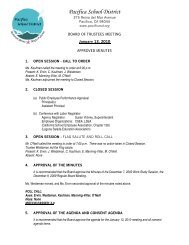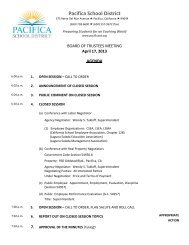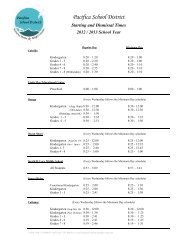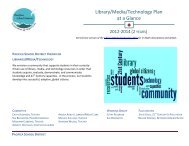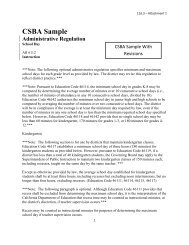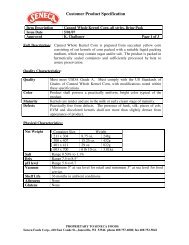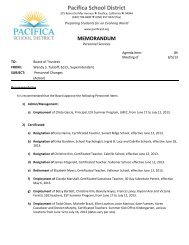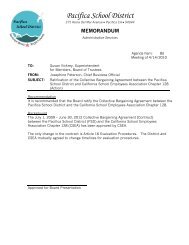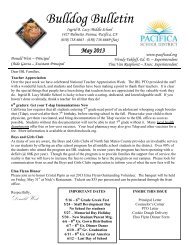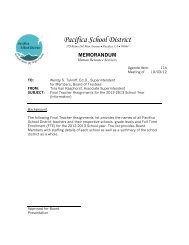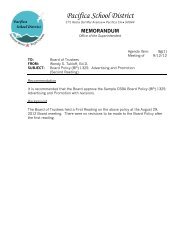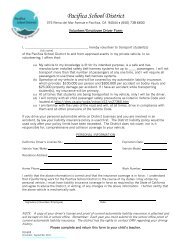SPECIAL EDUCATION PLAN - Pacifica School District
SPECIAL EDUCATION PLAN - Pacifica School District
SPECIAL EDUCATION PLAN - Pacifica School District
You also want an ePaper? Increase the reach of your titles
YUMPU automatically turns print PDFs into web optimized ePapers that Google loves.
PACIFICA SCHOOL DISTRICT VISION<br />
FOR <strong>SPECIAL</strong> <strong>EDUCATION</strong><br />
The <strong>Pacifica</strong> Special Education Program respects, values, and<br />
builds on the strengths and differences of our students.<br />
Through high‐quality instruction and strong partnerships with<br />
families, we instill a life‐long love of learning. We provide<br />
students with the tools to form meaningful relationships and to<br />
become successful, independent, and thriving members of the<br />
community.<br />
As a community of learners and educators we believe the<br />
following:<br />
Providing access to high‐quality curricula, services, and<br />
support in an inclusive environment allows children to reach<br />
their academic potential.<br />
Working in partnership with students and families creates<br />
opportunities for connections that nurture our students and<br />
enrich our community.<br />
Educating the whole child prepares our students to follow<br />
their own paths and fulfill their hopes and dreams.<br />
<strong>SPECIAL</strong> <strong>EDUCATION</strong> <strong>PLAN</strong>NING COMMITTEE 2010‐2011<br />
<strong>SPECIAL</strong> <strong>EDUCATION</strong> <strong>PLAN</strong><br />
<br />
2011‐2016<br />
VIRGINIA HARRINGTON, FACILITATOR BETH BOLDT, SDC TEACHER BETSY BARTLETT, SDC TEACHER ERIN BRAZILL, RESOURCE<br />
JON MOYER, RESOURCE GINGER JONES, PARENT KALIMAH SALAHUDDIN, PARENT PATTY MCNALLY, TEACHER<br />
JOANNE SIMONSON, PSYCHOLOGIST SHELLEY DENNY, SDC TEACHER TERI VOORHES, PARENT SHEILA HANSEN, COMMUNITY
Providing access to high‐quality<br />
curricula, services, and support<br />
allows children to reach their<br />
academic potential<br />
Current, research‐validated<br />
curricula with accompanying<br />
training enable special education<br />
staff to nurture, expand, and<br />
deepen their expertise and<br />
knowledge to best meet the unique<br />
needs of all their students.<br />
Providing students with I.E.P.’s<br />
access to curriculum aligned to the<br />
core content standards as well as<br />
opportunities to participate in<br />
enrichment activities and programs<br />
that their same‐aged peers enjoy to<br />
the maximum extent possible<br />
promotes equity and respects the<br />
rights of student.<br />
High‐quality specialized services<br />
and supports tailored to their<br />
strengths and learning needs<br />
central to our core education<br />
belief.<br />
Continuity in student assignment<br />
and the ability to be a member of<br />
the same educational community<br />
in the way that their same aged<br />
peers enjoy.<br />
GUIDING PRINCIPLES FOR <strong>SPECIAL</strong> <strong>EDUCATION</strong><br />
Working in partnership with<br />
students and families creates<br />
opportunities for connections that<br />
nurture our students and enrich our<br />
community.<br />
The acknowledgement and<br />
recognition of the valuable<br />
contributions families, agencies,<br />
district staff, and service providers<br />
make to the team’s understanding<br />
of the whole child is an essential<br />
aspect of an effective program.<br />
Welcoming and respecting families<br />
as knowledgeable and essential<br />
members of the team and partners<br />
is both a mandate and a value.<br />
Individual education plans are<br />
based on each student’s strengths,<br />
interests, and preferences.<br />
Community understanding of<br />
differences in learning, behavior,<br />
and communication promotes<br />
inclusiveness, respect as well as<br />
both individual and community<br />
health.<br />
Creating and supporting<br />
opportunities for mutual<br />
understanding fosters connections<br />
among students and ensures that<br />
school and the larger district<br />
community is safe and welcoming.<br />
Educating the whole child<br />
prepares our students to follow<br />
their own paths and fulfill their<br />
hopes and dreams.<br />
Fostering students’<br />
understanding of their strengths<br />
and their needs empowers the<br />
student to become skillful self‐<br />
advocates.<br />
Instruction in life‐skills and<br />
social‐skills is important for<br />
enhancing students’ ability to<br />
reach their academic potential<br />
and achieve success after they<br />
leave school.<br />
Students do best when included<br />
with the general population to<br />
the greatest extent possible.<br />
Acting with integrity ensures<br />
the best interests of the child<br />
are paramount.<br />
<strong>District</strong> personnel, families,<br />
agencies, and service<br />
providers respect students’<br />
confidentiality. Information<br />
is shared only with<br />
members of a student’s<br />
education team in adhere of<br />
practices that are designed<br />
to promote and protect<br />
student and family privacy.<br />
All members of the<br />
education team are<br />
respected and valued.<br />
All members of a student’s<br />
team are working in the<br />
best interests of the child.<br />
Open, honest, and timely<br />
communication respects<br />
team members’ time.<br />
A commitment to respect<br />
students and families in<br />
adherence with special<br />
education law.
INTRODUCTION<br />
The <strong>Pacifica</strong> <strong>School</strong> <strong>District</strong> Special Education Plan was written as a collaborative effort involving parents, special educators, general<br />
educators, and district staff. The plan is not a detailed list of services, programs, or descriptions. It is a vision, set of guiding principles,<br />
and areas of strategic focus aligned with the newly adopted PSD Strategic Plan and accompanying curriculum plans. Both the<br />
development of the plan and the plan itself reflect the importance of collaboration and respect of all stakeholders and their<br />
contributions as essential for the success of our students. Additionally, the committee affirms each student’s strengths as well as the<br />
desire to reject deficit language and models when speaking of students with IEPs. There is a strong belief that every child has strengths<br />
and is important members of our school community and district.<br />
While not the focus of the Special Education Plan, <strong>District</strong>, and SEPAC express an ongoing commitment to working collaboratively as<br />
parents/guardians and district staff to provide each special education student with appropriate educational services under an IEP, in<br />
a nurturing and positive education community. The aim is to ensure every child with an IEP receives an appropriate educational<br />
program such as speech and language therapy, occupational therapy, physical therapy, assistive technology as well as student and<br />
family engagement within the school community and district.<br />
The plan will be reviewed and updated on an annual basis.
STRATEGIC AREAS OF <strong>SPECIAL</strong> <strong>EDUCATION</strong> FOCUS:<br />
The table below provides a snapshot of the strategic areas of focus identified by the district special education committee that will enable<br />
us to achieve our vision for special education. These areas of focus address the three interrelated components of the district strategic<br />
plan that recognize our students’ right to learning that is rigorous, differentiated and holistic. These areas of focus address what<br />
students need to learn, how we can assess student progress, create and maintain healthy learning environments, and ways teachers<br />
collaborate and develop professionally in order to provide students with learning experiences that build a strong foundation for future<br />
choices.<br />
I. LEARNING THAT IS RIGOROUS<br />
1. <strong>Pacifica</strong> educators (including special education) use current, research‐validated curriculum that is aligned with the Common Core State Standards,<br />
and professional development, and are encouraged to expand their expertise and deepen their knowledge to meet the unique needs of all their<br />
students.<br />
I. A – Access to the<br />
CORE<br />
Implement districtwide<br />
adopted curriculum,<br />
practices, and<br />
assessments to the<br />
maximum extent<br />
possible ensuring<br />
alignment across grade‐<br />
levels and specialized<br />
special day class settings<br />
ensuring access to core<br />
curriculum and<br />
instructional program<br />
based on the Common<br />
Core State Standards<br />
(CCSS) and programs<br />
that their same aged<br />
peers enjoy.<br />
Are provided the<br />
opportunity and support<br />
to become<br />
knowledgeable about<br />
the Common Core State<br />
Standards.<br />
I.B – Assessment and<br />
Instruction<br />
Integrate the use of<br />
districtwide formative and<br />
benchmark assessments<br />
(with appropriate<br />
modification) as a key<br />
instructional practice.<br />
Every student will have<br />
access to the books and<br />
materials, assessments,<br />
daily schedules that<br />
include the same or<br />
similar activities as same<br />
aged peers in an inclusive<br />
educational environment.<br />
I.C – Research‐Based<br />
Curriculum<br />
Identify and maintain<br />
information and access<br />
to research based<br />
curriculum (including<br />
specialized curriculum<br />
including social skills,<br />
technology) to meet<br />
student learning and full<br />
implementation of<br />
Individual Education<br />
Plans.<br />
Ensure all special<br />
education teachers and<br />
students have access to<br />
core curriculum.<br />
Curriculum resource list,<br />
teacher surveys/input<br />
I.D – Professional Development<br />
Support and encourage special<br />
educators (teachers, aides, specialists,<br />
psychologist, and administrator)<br />
participate in ongoing districtwide and<br />
special education specific professional<br />
development to deepen expertise,<br />
preparedness, and knowledge that is<br />
consistent with current research<br />
validated educational practices. *<br />
For example: <strong>Pacifica</strong> special<br />
educators’ participation in Balanced<br />
Literacy, Mathematics, inclusive<br />
practices, differentiation, and 21 st<br />
century learning professional<br />
development with non‐special<br />
education teachers and site<br />
administrators<br />
*Ensure teachers have an opportunity<br />
to participate in professional<br />
development based on staff/student<br />
needs.<br />
I.E – 21 st Century<br />
Learning<br />
Experiences<br />
Collaborate with PEF,<br />
PSV and other<br />
community<br />
organization to<br />
maximize the<br />
inclusion of special<br />
education students<br />
ensuring they have<br />
equity in access to<br />
the types of<br />
experiences as same<br />
school aged peers<br />
enjoy (For example:<br />
the 21 Century<br />
Education<br />
Experiences).
II. LEARNING THAT IS DIFFERENTIATED<br />
2. <strong>Pacifica</strong> students with special needs receive differentiated high‐quality specialized services and supports tailored to their strengths<br />
and learning needs within an inclusive setting.<br />
II. A – RTI 2 II. B – Technology tools for differentiated support.<br />
: Special educators participate in the support and development<br />
and support implement of Tier I differentiated and enriched first<br />
instruction; additional Tier II support for students who are .5 ‐ 2 years<br />
below grade level; and are directly involved in the support of Tier III<br />
students who are 2 or more years below grade‐level (special education<br />
and non special education students. In this model <strong>Pacifica</strong> students with<br />
the greatest needs have access to high‐quality services and supports<br />
provided by highly‐ qualified teachers and specialists.<br />
III. LEARNING THAT IS HOLISTIC<br />
3. Promote opportunities that nurture students and enrich the community. <strong>Pacifica</strong> <strong>School</strong> <strong>District</strong> recognizes the valuable<br />
contributions families, teachers, support providers, administrators, and other agencies in understanding and upholding the whole child<br />
through high‐quality specialized services tailored to student strengths and learning needs.<br />
III.A – Individual Education<br />
Plan (IEP) Teams<br />
Nurture and maintain a<br />
district culture that<br />
recognizes the valuable<br />
contributions of all<br />
constituents with a specific<br />
emphasis on the<br />
contributions families,<br />
partnering agencies, and<br />
providers make in the teams<br />
understanding of the whole<br />
child.<br />
Honor the expertise and<br />
contribution of all members<br />
of the education<br />
team/community. With the<br />
team always keeping the<br />
students’ interests, learning<br />
III. B – Promote Awareness<br />
of Differences as a Strength<br />
Build and foster<br />
inclusiveness in our school<br />
and district community by<br />
promoting acceptance,<br />
responsiveness, and<br />
understanding of differences<br />
in learning, behavior, and<br />
communication.<br />
The development of social<br />
skills is supported in an<br />
articulated and explicit<br />
manner in all special<br />
education classrooms and<br />
through social skills<br />
development groups as<br />
appropriate.<br />
III.C – Inclusiveness in<br />
Opportunity and Practices<br />
PSD across the district<br />
strives for and promotes<br />
inclusiveness. Special<br />
education students are<br />
included in many of the<br />
same activities as their<br />
typical peers (such as<br />
fieldtrips, enrichment and<br />
special events or<br />
programs).<br />
Non‐special education<br />
teachers, special<br />
education teachers and<br />
paraprofessionals are<br />
provided with training and<br />
supports to increase<br />
students’ success in an<br />
III.D – Communication<br />
(Structures/Systems)<br />
Communication structures<br />
are developed and<br />
maintained that promote<br />
mutual respect and<br />
collaboration.<br />
Parents/guardians and other<br />
IEP team members are<br />
considered in the IEP<br />
scheduling process with<br />
meetings scheduled a head<br />
of time as much as possible<br />
to ensure full team member<br />
participation.<br />
Continue the practice of<br />
regular ongoing meeting<br />
between the Laguna Salada<br />
III.E –Special Education<br />
Advocacy and Law<br />
PSD is a community of<br />
learners with parents<br />
and educators keeping<br />
informed about special<br />
education law,<br />
procedural safeguards,<br />
timelines, educational<br />
benefits, and least<br />
restrictive environment<br />
etc.<br />
SEPAC and other<br />
opportunities are used<br />
to support educator<br />
and parent knowledge.<br />
Using knowledge,<br />
structures, and
strengths, and preferences<br />
as a primary focus when<br />
developing Individualized<br />
Education Plans.<br />
Ensuring IEP teams have<br />
systems and structures to<br />
ensure consultation and<br />
collaboration between all<br />
team members. Including<br />
active and inclusive<br />
participation.<br />
The norm is for all IEP team<br />
members and other meeting<br />
participants to come to<br />
meetings prepared and<br />
ready to participate focused<br />
on student needs.<br />
Develop Library/Resource<br />
Center for Parents<br />
Expand Ability Awareness<br />
program to all school sites<br />
through quarterly SEPAC<br />
Workshops that are open to<br />
educators, parents and<br />
community.<br />
Promote ability awareness,<br />
Diversity Days, and other<br />
opportunities for educating<br />
students and staff about<br />
differences as a means of<br />
promoting acceptance and<br />
responsiveness to all people.<br />
Expand reverse<br />
mainstreaming and<br />
mainstreaming<br />
opportunities in PSD<br />
classrooms and schools.<br />
inclusive education<br />
community that includes<br />
mainstreaming etc.<br />
An Effort will be made at<br />
all meetings, conferences,<br />
and events to ensure all<br />
voices are heard and<br />
respected for the<br />
contribution made.<br />
Education Association (LSEA)<br />
special education<br />
subcommittee that includes<br />
special educators,<br />
psychologist, specialist, and<br />
district administration to<br />
address special education<br />
related student and teacher<br />
needs.<br />
The Special Education<br />
Parent‐Advisory Committee<br />
(SEPAC) will continue to<br />
meet quarterly and serve as<br />
a respectful and<br />
collaborative bi‐directional<br />
communication and learning<br />
forum. These meetings are<br />
open to parents, educators,<br />
and the community.<br />
Social media tools and<br />
opportunities; such as<br />
<strong>Pacifica</strong> Tribune, <strong>Pacifica</strong><br />
Patch, and Dandelion<br />
Magazine etc. are used to<br />
promote a positive image of<br />
diversity and student assets.<br />
processes with<br />
integrity to make<br />
decisions that both<br />
support the student<br />
and maintain<br />
confidentiality.
2012‐2013 <strong>SPECIAL</strong> <strong>EDUCATION</strong><br />
ANNUAL OUTCOME: Initiate implementation of the finalized the PSD Special Education Strategic Plan, on the district website, and begin to implement strategic areas of<br />
focus.<br />
STANDARDS: ELA/Literacy and Math Common Core State Standards as well as California State Content Standards in all other content areas<br />
INSTRUCTIONAL MATERIALS WE USE:<br />
RESEARCH VALIDATED CURRICULUM AND <strong>EDUCATION</strong>AL PRACTICES ALIGNED WITH THE COMMON CORE STATE STANDARDS<br />
ASSESSMENT:<br />
HOW WE KNOW STUDENTS ARE LEARNING<br />
• Interim common running records, Developmental Reading Assessment (DRA2)<br />
• MARS – Math Performance Assessment<br />
• Performance Assessment, California Standards Test (CST), CMA, CAPA<br />
• Individual Education Plan (including annual evaluation of progress towards goals)<br />
Conferencing, and classroom formative assessments<br />
TIMELINE/KEY PEOPLE ACTIVITIES MEASUREMENT/EVIDENCE FUNDING<br />
SOURCE<br />
2012‐17 Special Education<br />
Director and Special Education<br />
Teachers<br />
8/2011 –Teachers, ELA<br />
Facilitator, Teachers College<br />
Reading and Writing Project<br />
staff developers, and district<br />
leadership<br />
Special Education Curriculum Audit (and ongoing monitoring to ensure access used) –<br />
1. Ensure special education teachers have access to core instructional curriculum and<br />
supplemental materials<br />
2. Curriculum and supplemental materials in use and accessible to students<br />
3. Support (2012‐13) and ensure implementation (2013‐14) of the newly adopted Functional<br />
Skills Curriculum<br />
Support Balanced Literacy and Common Core State Standards for English Language<br />
Arts/Literacy (CCSS) Implementation:<br />
(2012‐2014)<br />
1. Provide the necessary instructional and supplemental materials to ensure student access<br />
to Reader's Workshop (2012‐2014)<br />
2. Support special education teachers in establishing the connection between Reading and<br />
Writing Workshops to ensure differentiate curriculum in both areas of ELA (2012‐2014)<br />
3. Provide structures and opportunities for special education teachers and general<br />
education teachers to collaborate and reflect with colleagues to process and share<br />
successful strategies and curriculum that focused on successful access for all students<br />
(2012‐2016)<br />
4. Evaluate students access to core curriculum through Reader's and Writer's Workshop<br />
(2011‐16)<br />
5. Audit of instructional curriculum and supplemental materials to continue to ensure<br />
access to the <strong>District</strong>'s Balanced Literacy Program.<br />
8/ 2011 – 21 st Century Learning –<br />
1. Provide special education students with differentiated opportunities to participate in PEF<br />
funded 21 st Century Education Experiences (2012‐16)<br />
2. Ensures students have access to assistive technology related to students with special needs<br />
with adequate professional development for staff and knowledge as a district (2012‐16)<br />
3. Professional development and/or consultation with special education staff regarding the use<br />
of technology that will support access to the core curriculum and address individual needs<br />
(2012‐ 16)<br />
Curriculum Audit Survey Administered on<br />
an annual basis<br />
Artifacts: PD agendas, reflections<br />
Observations<br />
Artifacts: PD agendas, reflections,<br />
observations<br />
Annual <strong>District</strong> Technology Use Survey<br />
(S)
8/ 2011 – Parent/Guardians,<br />
teachers, administration, and<br />
community members<br />
4. Ensure all special education teachers are issued a functioning (laptop, desktop and/or<br />
iPad/tablet computers) with reliable access to printer and internet access (2012‐13)<br />
5. Provide special needs students access to computers/tablets, etc., to support access to<br />
curriculum materials (2012‐16)<br />
6. Equip primary and secondary special education (SDC) classrooms with the same technology<br />
(ELMO, etc.) as general education classrooms at the same grade level (2012‐16)<br />
7. <strong>District</strong> will develop the role of the assistive technology specialist(s) within our district (2013‐<br />
14)<br />
8. Specialist(s) will consult with all special education teachers regarding classroom and individual<br />
needs, prior to making a referral for SMCOE or agency based assistive technology services<br />
(2013‐16)<br />
9. Use Edmodo (online education community) to create a special education group that<br />
promotes ongoing dialogue between PSD special educators (2011‐16)<br />
Family and Community Engagement<br />
1. Include Special Day Class families are in all school/district/PTO communication<br />
Create survey for SEPAC Rep's to complete for status at each campus by assisting each<br />
school community in establishing and maintaining the necessary structures and support<br />
(2012‐13)<br />
2. Write by‐laws and Board positions for SEPAC (2012‐13). Maintain SEPAC membership –<br />
two active parent Rep's per campus, a principal, the Special Education Administrator, and<br />
a special Education staff member (2012‐16)<br />
3. Support and encourage participation on SEPAC Yahoo Group where Workshops,<br />
Community Resources and changes in the Special Education Dept. can be disseminated to all<br />
families (2012‐16)<br />
4. SEPAC will develop and maintain a parent‐to‐parent Library/Resource Center (using book<br />
donations from families and community) located at LMEC (2012‐16)<br />
5. Ensure six SEPAC members to attend SELPA Parent Resource Council Training (2012‐13)<br />
6. Collaborate with Ocean Shore staff and Diversity Leadership Group in documenting the<br />
process used in developing their annual Ability Awareness Day to serve as a resource for<br />
other schools (2012‐13)<br />
7. Begin sponsoring and supporting one campus at a time to have an Ability Awareness Day<br />
(2012‐16)<br />
8. Conduct monthly SEPAC meetings and sponsor three workshops per school year. Topics to<br />
include: Transition to High <strong>School</strong>, Resource Fair (2012‐16)<br />
9. Work with Special Olympics for <strong>District</strong> activities such as Super Sports Day and campus<br />
activities such as basketball tournament including general education and students with<br />
IEPs (2012‐16)<br />
10. Establish email communication flow for all families receiving services<br />
Agendas‐Meeting minutes<br />
Workshop Sign In sheets and parent<br />
feedback<br />
Feedback from SELPA and SEPAC<br />
members will share out<br />
Functioning Library and Inventory<br />
Report out and implementation




